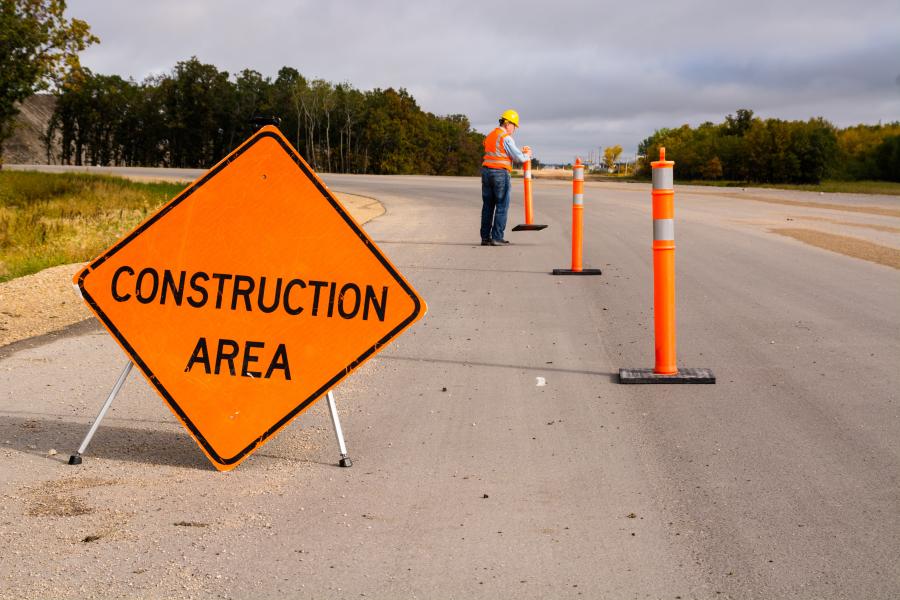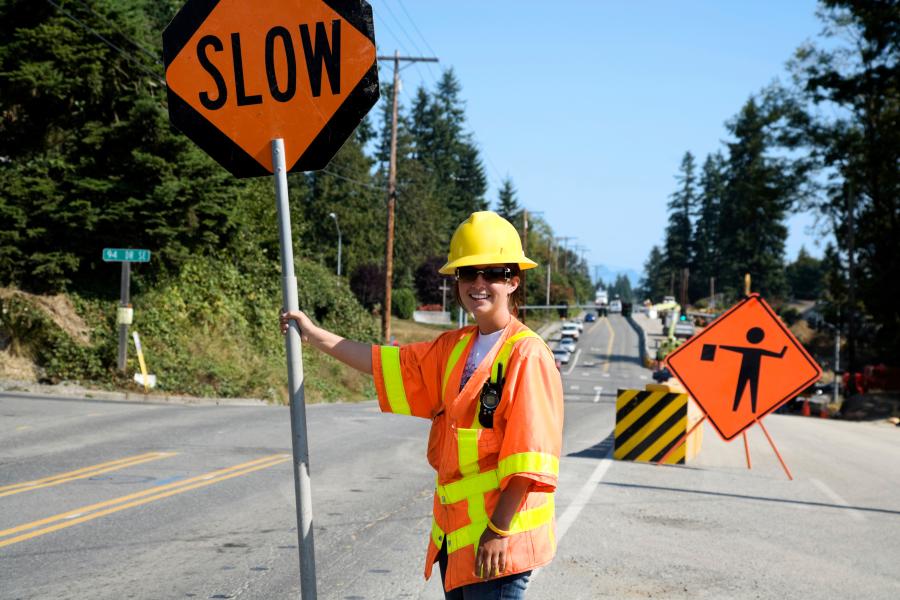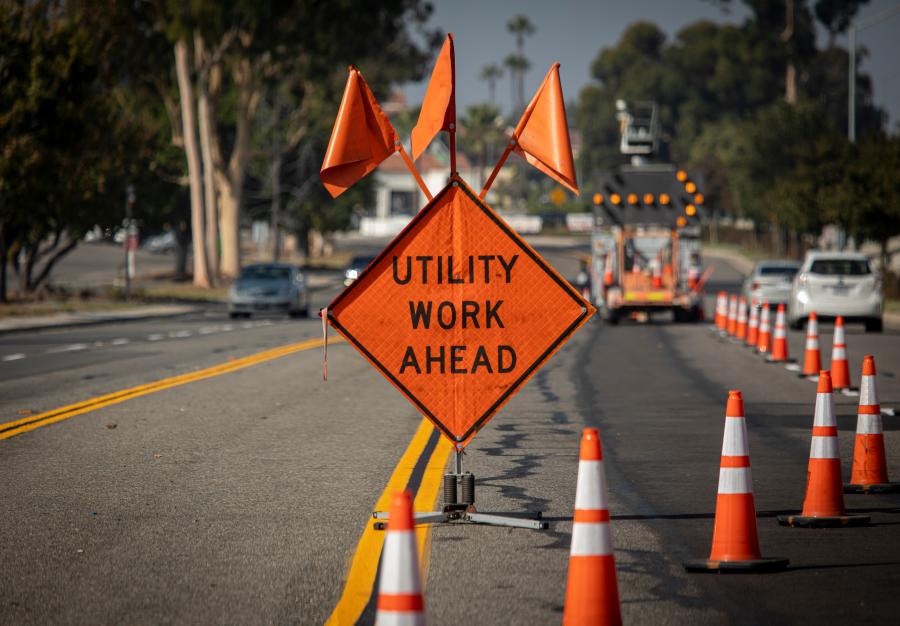Adobe photo
The construction industry, through AGC and ARTBA, has registered its thoughts on the proposed rule changes. Both associations think the rules could go further.
FHWA and the road construction industry agree on one thing: The safety of crews in work zones is a priority. Ramped-up construction means the risk to highway workers is as great or greater this year than last. FHWA has proposed rule changes to meet broader impacts of work zones on both driver mobility and worker safety. AGC and ARTBA believe road workers should be the priority.
In September, FHWA announced proposed rulemaking amending its traffic safety and mobility regulations. The agency said it recognizes increasing road construction activity can lead to traffic disruptions resulting in congestion and crashes. Loss of productivity and public frustration with work zones also were cited in the proposed rulemaking.
The goal is a "more coordinated and comprehensive" approach to safety and mobility issues across project stages, said FHWA.
AGC responded with a letter outlining the association's emphasis on worker safety.
"Work zone safety continues to be one of the biggest concerns among highway contractors," said AGC.
Last spring, the association released results of a highway work zone study conducted among its members.
"In fact, 97 percent of contractors report that highway work zones are either as dangerous or more dangerous than they were a year ago."
Tracking a "concerning rise in crashes, injuries and fatalities," the association said it hopes to see a reversal in "this disturbing trend."
Statistics Say It All
The AGC safety survey found that many motorists are in even greater danger from highway work zone crashes than construction workers.
Ken Simonson, association chief economist, said 28 percent of responding contractors experienced crashes that resulted in injury to construction workers.
"But more than twice as many firms — 59 percent — reported experiencing a crash in which drivers or passengers were injured."
The survey noted that work zone crashes are twice as likely to result in fatalities to drivers or passengers as construction workers. In fact, 8 percent of contractors in the survey reported workers killed in crashes, and 16 percent noted drivers or passengers killed.

Adobe photo
"In many cases, vehicle speeding contributes to these crashes in work zones," said Steve McGough, president of HCSS, survey partner with AGC.
"Utilizing speed cameras with a zero-tolerance policy would go a long way to protect the traveling public and our workforce."
Concerning was Simonson's revelation that 97 percent of contractors believe work zones are either as dangerous, or more dangerous, than a year ago. More than half of respondents want automatic ticketing for speeding in work zones, noted the economist. Understandably, 79 percent want a greater police presence and 65 percent want stricter enforcement.
AGC pressed states to prioritize education and enforcement in order to make work zones safer.
The association said it wants every state to implement a driver work zone safety course and deploy more police to work zones. AGC also urged states to authorize speed cameras in work zones and set tougher penalties for unsafe work zone driving.
"Nobody should die because our laws fail to penalize unsafe operations in work zones in the same way they punish drunk driving and stigmatize not using a seat belt," said Simonson.
The association also urged motorists to be careful when passing through highway work zones. Simonson said AGC is releasing a new video featuring highway workers pleading with motorists to be more careful when passing through work zones.
FHWA's Proposed Rule Changes
In its proposal, DOT said its "principal mission is to ensure America is the safest, most efficient and modern transportation system in the world."
The proposed changes affect work zone safety and mobility and temporary traffic control devices. The changes would "clarify and correct certain aspects of the regulations that were last modified in 2004 and 2006, respectively," said FHWA.
Work zones are a "necessary part of meeting the need to maintain and upgrade our aging roadway infrastructure," the agency said. "Work zone activities are expected to increase significantly with the passage of the Bipartisan Infrastructure Law [BIL]."
The BIL earmarks some $350 billion for highway programs from 2022 through 2026, FHWA noted.
"This represents a 55 percent increase in highway and bridge program funding over the Fixing America's Surface Transportation [FAST] Act" of 2015.
Regardless of increased funding, work zones already result in significant safety and mobility impacts, FHWA said adding that 857 people died in 774 crashes.
In 2020, the NHTSA said 117 road construction workers suffered fatal occupational injuries. And 62 of those were workers hit by a motor vehicle.
And while FHWA offers resources to assist states in implementing the revisions safety and mobility rule, implementation is varied across the country. The agency said many states have developed and implemented systematic procedures to assess anticipated work zone impacts in project development. But only a few have procedures to manage impacts during project implementation or to perform post-project evaluations.

Adobe photo
And that's despite increased availability of data sources and methodologies available to do so.
Further, many states have not embraced data-driven performance-based process reviews that these resources offer, said FHWA, even with encouragement.
"The FHWA acknowledges that a lack of clarity in what is required by certain parts of the regulation may partially explain the uneven adoption."
The existing regulation has language considered necessary at the time to ensure state understanding but now superfluous to implementation, the agency added.
FHWA said it also recognizes the frequency of agency process reviews may hamper some states from more in-depth assessments.
BIL calls for revisions to ensure that the work zone process review is required not more frequently than once every five years. Plus, urged revisions would ensure only a project with a lane closure for three or more days shall be considered significant. And a state shall not be required to develop or implement a transportation management plan for a highway project not on the Interstate System.
This, "if the project requires not more than three consecutive days of lane closures," said FHWA.
Where temporary traffic control devices are concerned, FHWA proposes adding a new subpart on appropriate use of and expenditure of funds. This would include uniformed law enforcement and protective measures between workers and traffic.
It would also cover installation and maintenance of temporary devices during construction, utility and maintenance operations.
"The intent of the regulation was to reduce both worker and motorist fatalities and injuries in work zones," said the agency. "Overall, work zone fatalities did decrease significantly from a high of 1,068 work zone fatalities in 2004 to 590 fatalities in 2011. Unfortunately, since then that trend has reversed, growing from 590 fatalities in 2011 to 857 fatalities in 2020."
The proposal also provides for "positive protective measures" to separate workers from traffic in all work zones in areas that offer no means of escape.
Industry comments support the rule's intent, several respondents noted requirements lack supporting research indicating the criteria were appropriate.
"This created significant concerns with some respondents, who viewed the requirements as arbitrary and overly prescriptive," said the agency.
In response, FHWA modified the final rule to require longitudinal traffic barrier and other protection devices to be based on an engineering study.
The final rule also required states to consider positive protection where it offers the highest potential for increased safety for workers and road users.
Industry's Measured Response
Both AGC and ARTBA responded with suggested changes to the FHWA proposal.
ARTBA said that while it agrees with many of the proposed changes, more could be done to enhance the rule's effectiveness.
"ARTBA's highest priority is the safety of its members," the association said in announcing its response to the federal agency. "FHWA's proposal, while addressing shortcomings of previous regulations, needs additional streamlining to effectively prevent highway injuries and fatalities."

Adobe photo
The association asked for additional explanation about predefined thresholds referred to in the proposal, and how the agency determines plan adequacy.
ARTBA also wants safety training integrated into all project design and management.
Finally, the organization pressed for increased use of positive protection between workers and motorists.
"With these additions, we believe the rule will go far toward implementing the U.S. Department of Transportation's National Roadway Safety Strategy."
The ARTBA response said the result will be a comprehensive, systematic approach to reducing unnecessary roadway deaths and injuries.
"ARTBA has been a proponent of FHWA's work zone safety strategic plan being incorporated as the sixth pillar in the National Roadway Safety Strategy."
The association said again that its previous recommendation to ensure roadway and work zone safety strategies are interconnected.
Meanwhile, AGC maintains that "the balance between mobility and safety should always skew in favor of the safety of the workers."
The association's response to FHWA supports the use of positive protection devices. AGC wants the technology included by state DOTs in significant construction zones.
In its survey, AGC found that 55 percent of highway contractors report motor vehicles had crashed into their construction work zones during the past year.
At the time, the association called for enforcement and education measures at the state and local levels with the goal of improving work zone safety.
"Elected and appointed officials are not doing enough to protect workers and motorists in highway work zones," said AGC's Simonson.
"Our transportation networks may be invaluable, but the lives of workers and motorists are priceless," added Simonson, who authored the member survey. CEG
Today's top stories























